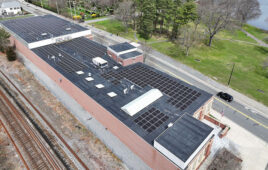Global irradiance is the amount of radiant energy (electromagnetic radiation from the sun) on a flat surface. It’s important to measure irradiance to know how much power a solar project could potentially harvest from the Sun. The irradiance is measured in watts per square meter (W/m2). A pyranometer is designed to measure this irradiance from all directions.
Dmytro Podolskyy, business manager of pyranometer manufacturer Kipp & Zonen, said that irradiance data is crucial at all stages of a solar energy project. “Even before building a power plant, a pyranometer is advised for prospecting to find the optimal location,” he said. “Designing a solar energy system with optimal performance requires knowing how much energy it will receive from the sun.” For example, a solar plant with nominal power of 1 MW will produce a different amount of energy (kWh) depending on the solar resource available at the location. Reliable bankable solar irradiance data is required by investors for feasibility studies and to reduce uncertainty of project performance. Therefore, Podolskyy explained that monitoring irradiance is important for reliable estimation of profitability of a solar project.
Furthermore, irradiance data such as the ratio between the direct and diffuse radiation on site is also important when choosing solar generating technology (i.e. PV, CPV or CSP) or racking technologies (i.e. fixed or tracking panels). Direct solar irradiance is the rate of solar energy arriving at the Earth’s surface from the Sun’s direct beam on a plane perpendicular to it and is measured by a device mounted on a solar tracker called a pyrheliometer. The tracker follows the sun to make sure the beam is directed into the device. Diffuse solar irradiance is the rate of incoming solar energy on a horizontal plane at the Earth’s surface as the Sun’s beams are scattered by the atmosphere. A pyranometer measures this with its glass dome shaded from the Sun’s beam.
At an operational solar plant, a pyranometer measures the solar energy that is coming into the system while power meter measures what electrical power it produces. Knowing these two values at all moments allows calculating the performance ratio (PR) of a solar plant. PR is an important parameter that can indicate if the solar plant is operating well or if there are issues such as soiling, shading, short-circuits or module degradation.
There are two types of pyranometers: thermopile pyranometers and semiconductor pyranometers. A thermopile pyranometer is the “true” pyranometer that actually measures the total amount of radiation on a surface, according to Podolskyy. It has a thermopile detector (a device that converts thermal energy into electrical energy) with strongly light-absorbing black paint that consumes all radiation from the sun equally. This creates a temperature difference between the black surface of the sensors and the body of the instrument and results in a small voltage at the sensor that can be measured and translated into W/m2. However, a semiconductor or silicon pyranometer uses a photodiode (a device that converts light into current) to create an electrical signal from the incoming solar radiation. The disadvantage of the silicon pyranometer is that its spectral sensitivity is limited, which means it simply does not see the whole spectrum of the sun. Not surprisingly, this can result in errors of measurements.
Thermopile pyranometers can be divided into three classes defined by the ISO 9060 standard that indicates their precision: Second Class, First Class and Secondary Standard. Podolskyy said Secondary Class pyranometers are the best fit for solar. “Secondary Standard pyranometers are the most precise and are normally used for high-quality measurement of solar radiation at weather stations and solar energy projects due to their long term stability and low error rates,” he said.
A pyranometer provides an analogue voltage output, but Podolskyy added that some pyranometers are available with a smart interface and offer standard industrial output (4-20mA and 0-1V) in addition to a digital Modbus RS485 output.
 A pyranometer can be installed on its own or as a part of a meteorological station. “Often on a large solar plant you will find one or several meteorological stations that measure important weather parameters such as temperature, relative humidity, wind speed and direction and solar radiation,” Podolskyy said. “You will also find multiple pyranometers installed next to and in the same angle as PV panels to locally monitor the Global Tilted Irradiance, also called Plane of Array (POA) irradiance.” POA irradiance received by tilted PV panels partly includes the radiation reflected from the ground as well as the radiation from the sun and sky. The measurements taken by pyranometers can be compared with models that calculate irradiance on the array from the sky under different conditions. This step is critical for efficiently modeling the overall performance of solar energy projects.
A pyranometer can be installed on its own or as a part of a meteorological station. “Often on a large solar plant you will find one or several meteorological stations that measure important weather parameters such as temperature, relative humidity, wind speed and direction and solar radiation,” Podolskyy said. “You will also find multiple pyranometers installed next to and in the same angle as PV panels to locally monitor the Global Tilted Irradiance, also called Plane of Array (POA) irradiance.” POA irradiance received by tilted PV panels partly includes the radiation reflected from the ground as well as the radiation from the sun and sky. The measurements taken by pyranometers can be compared with models that calculate irradiance on the array from the sky under different conditions. This step is critical for efficiently modeling the overall performance of solar energy projects.





What is the norm / Recommended practice for No if Pyranometers / Weather Monitoring Station (WMS) in a large scale utility plant? Say 100 MW, spread over ~ 400 Acres of land?